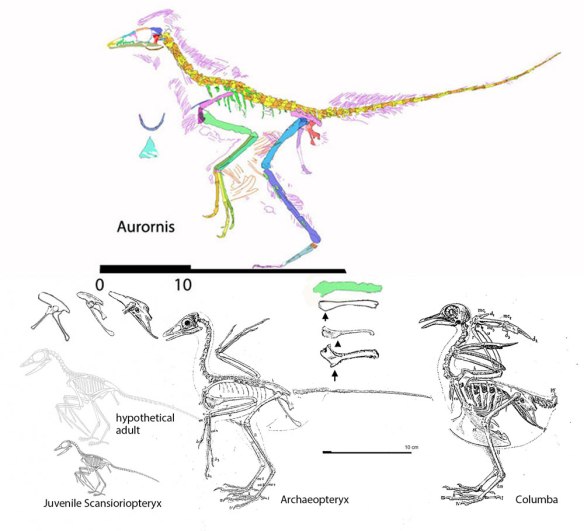| Online: | |
| Visits: | |
| Stories: |
Problem: the Scansoriopteryx pelvis and humerus
I’m guessing that most paleontologists agree
that Scansoriopteryx (Fig. 1) is a strange little theropod dinosaur in the lineage close to birds. After all, it has feathers! And it has very theropod-like bones.

Figure 1. Scansioropteryx compared to Aurornis, Archaeopteryx and Columba, the pigeon. Note the shapes of the pelvis and the humerus. Not sure if the Aurornis humerus (green) is right side up or upside down. Below it are the humeri of Scansioropteryx, Archaeopteryx and Columba, the pigeon. Click to enlarge.
However, there is disagreement on the nesting of Scansioropteryx
Czerkas and Feduccia (2014) wrote: “Unlike theropod dinosaurs, invariably exhibiting a completely perforated and open acetabulum, Scansoriopteryx has a partially closed acetabulum, and no sign of a supra-acetabular shelf or an antitrochanter. Along with the mostly enclosed acetabulum indicated by the surface texture of the bone within the hip socket, the proximally oriented head of the femur is functionally concordant with a closed or partially closed acetabulum and with sprawling hind limbs.”

Figure 2. Pelvis of Scansioropteryx with DGS layering. Apparently the left isichium was slightly displaced, covering the acetabulum. When right and left elements are compared, the acetabulum appears to be open as in other theropod dinosaurs. Note the left pubis was flipped on its long axis durring taphonomy. The femur appears to have an theropod-like head and neck (ignore the overlapping matrix that gives it a notch).
The crushed pelvis
of Scansioropteryx (Fig. 2) may have been misinterpreted. From what I can tell the left ischium had shifted over the acetabulum and other pertinent post-acetabulum areas, obscuring the open acetabulum (which is plainly visible on the right side). This hypothesis assumes that both ischia were the same length as their posterior tips must meet.
Apparently the left femur
has a more developed head when crushed in an appropriate plane. The right femur had somewhat of a head, but it was crushed in an inappropriate plane.

Figure 3. Femur and humerus of a juvenile Scansioropteryx. The femoral head is there, just not very well developed. The humerus lacks a deltopectoral crest extending a quarter of the way down the humerus, but a sister taxon, Aurornis (Fig. 4), also lacks this crest. Those traits do not prevent these taxa from being theropod dinosaurs.
The deltopectoral crest
on most dinosaurs, including Archaeopteryx (Fig. 1), is prominent and extends down a quarter of the humerus. We don’t see this in Scansioropteryx (Fig. 3). But then again, we don’t see this in Aurornis (Fig. 4) either. That doesn’t delete them from the theropod clade because every other aspect of their anatomy says: theropod!

Figure 4 Aurornis humerus. Note the near complete lack of a deltopectoral crest. And certainly not a quarter of the way down the humerus.
If lacking a long deltopectoral crest removes a bird from theropod ancestry then Struthio the ostrich (Fig. 5) is not a theropod either. I’m not seeing much of a deltopectoral crest on Compsognathus or Juravenator either. Did Czerkas and Feduccia set up a straw dog? A red herring?
Maybe that crest is a clue
toward flight/flightlessness in birds (other than the obvious clue of relative wing size!). Applied to Aurornis and Scansioropteryx, neither was flighted. Applied to most theropods and I’ll ask you to rely on relative forelimb size and overall size (Fig. 5). After all, T-rex has a large and appropriately placed deltopectoral crest.
They key to nesting taxa in a cladogram is to:
produce a cladogram. Unfortunately Czerkas and Feduccia did not do this. So if Scansioropteryx was not a theropod, what was it? They don’t tell us.
Here’s what they do tell us: “Scansoriopterygids are not members of either Saurischia or the derived clade of carnivorous Theropoda, which birds have been largely thought to be derived from, based on phylogenetic analyses. Characteristics such as the structure of the deltopectoral crest of the humerus indicate affinities that have been attributed to Dinosauriformes, but it could be further argued that the lack of the offset articular head of the femur suggests an ancestry that predates Dinosauromorphs well into Ornithodira or Avemetatarsalia, if not further into more basal Archosauria.”
You can’t say what Scansoriopterygids are not!
You have to say what they are! And be specific! (On the same note, don’t be like so many modern workers who tell you pterosaurs are archosaurs, but can’t give you a good sister taxon or ten, like the large reptile tree can!)
And you can’t
just pick out a few traits and think you have a solution. You have to examine a large suite of traits (preferably 150+) from every aspect of the taxon. You don’t want to pull a Larry Martin like these guys did with Dimorphodon.
Sometimes paleontologists forget the key to nesting taxa.
Then they’re in deep with their critics. Sometimes they toss out key taxa. Sometimes paleontologists dismiss as impossible what a large cladogram recovers. None of this is acceptable — most of the time — to most paleontologists. : )
References
Czerkas SA and Feduccia A 2014. Jurassic archosaur is a non-dinosaurian bird. Journal of Ornithology 155(4):841-851.
Pop C and Pentea M 2007. The osteological features of the skeleton in ostrich (Struthio camelus). Lucrari stiinifice medicine veterinary 15:561-568 Timisoara (online here).
Source: https://pterosaurheresies.wordpress.com/2015/03/06/problem-the-scansoriopteryx-pelvis-and-humerus/





